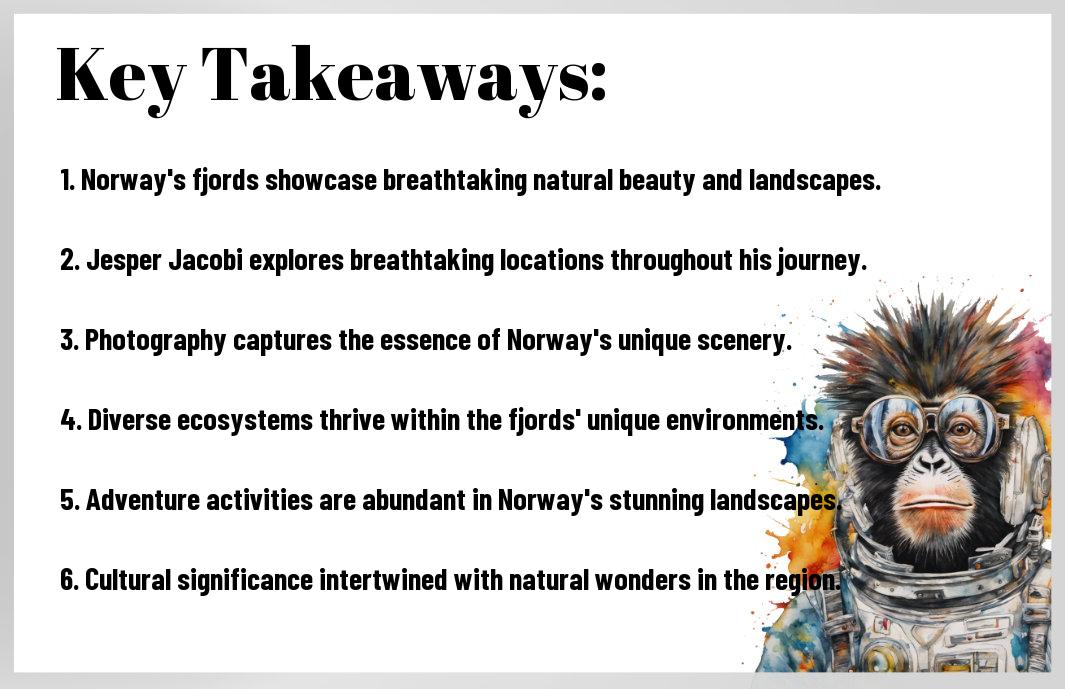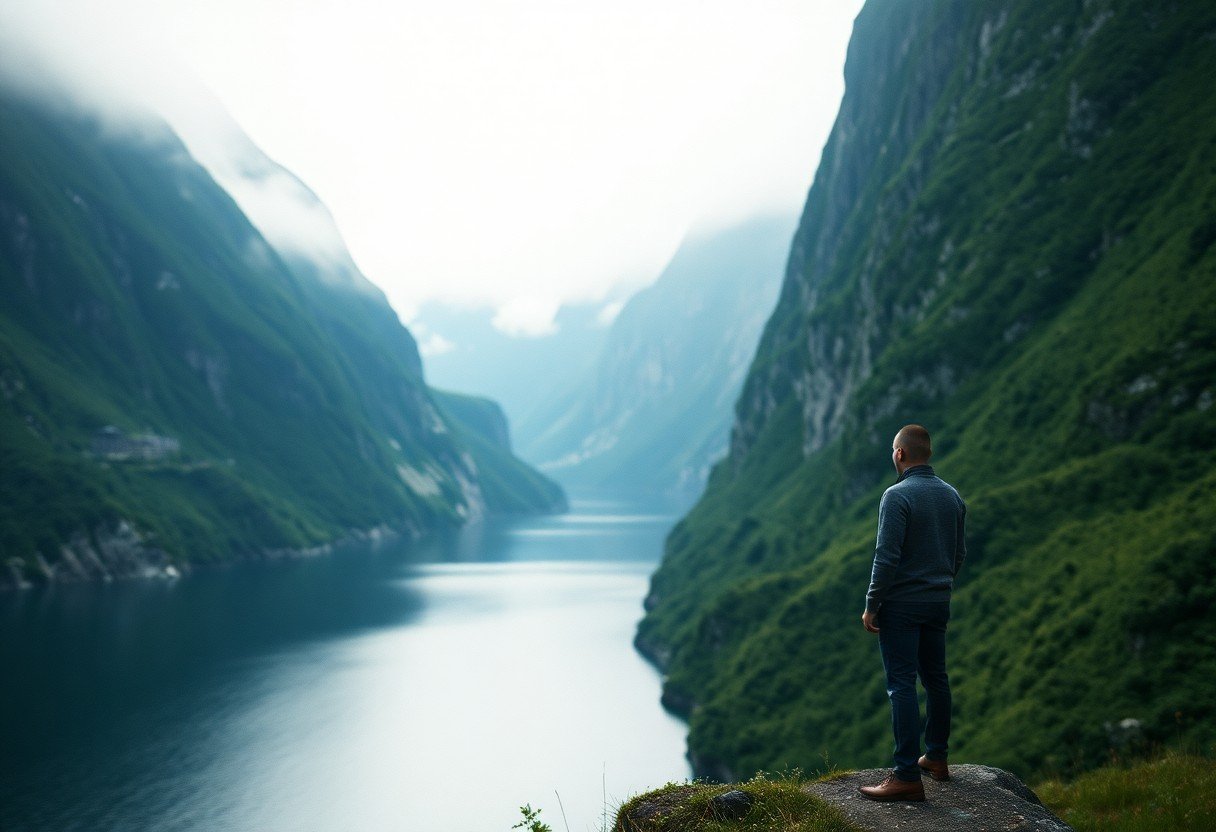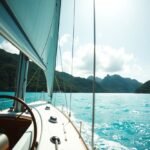You are about to initiate on a journey through the breathtaking landscapes of Norway’s Norwegian fjords, a natural wonder that captivates travelers from around the globe. In this blog post, you’ll discover the artistry of Jesper Jacobi, who skillfully captures the essence of these majestic formations through his lens. Explore the unique geology, rich history, and stunning vistas that define this iconic region, while gaining insights into how Jacobi’s work elevates your appreciation for nature’s masterpieces.

The Norwegian Fjord Landscape
To truly understand the Norwegian fjords, you must immerse yourself in their striking beauty and breathtaking formations. These stunning landscapes are carved by glacial activity, providing you with an awe-inspiring view of steep cliffs, deep waters, and lush greenery that showcases nature’s artistry at its finest. You’ll find yourself captivated by the tranquility and majesty that defines these unique ecosystems, as each bend in the water reveals another facet of their vibrant character.
Geological Formation and History
After centuries of glacial sculpting, the fjords of Norway emerged as some of the most remarkable geological features on Earth. Formed during the Ice Age, these valleys were deepened by the relentless movement of glaciers, leaving behind steep cliffs and distinct U-shaped valleys. As glaciers receded, the sea filled these valleys, creating the stunning landscapes you see today. This geological history not only showcases the power of nature but also contributes to the unique ecosystem that thrives in these spaces.
Unique Characteristics of Norwegian Fjords
Beside breathtaking views, Norwegian fjords possess unique characteristics that distinguish them from other coastal formations. Their steep granite cliffs rise dramatically from the water, often plunging hundreds of meters deep, which creates profound contrasts in both landscape and biodiversity. Furthermore, the complex interplay of tides, freshwater flows, and spectacular waterfalls enriching the fjord ecosystem enhances your experience of nature’s diversity as you explore these majestic surroundings.
Fjord waters are also fresh and deep, typically teeming with marine life that you may encounter during your visit. The unique weather patterns influenced by the surrounding mountains create distinct microclimates, fostering varied and lush plant life that thrives in the sheltered spaces. Additionally, the presence of idyllic villages and historical sites along the shores presents you with a fascinating cultural experience intertwined with the natural beauty. This interplay of geography, climate, and human history elevates the Norwegian fjords into a realm of unparalleled splendor you won’t want to miss.
Jesper Jacobi’s Journey
One of the most captivating aspects of Jesper Jacobi’s journey through the Norwegian Fjords is how he immerses himself in the natural surroundings. Each trek and exploration is meticulously documented, showcasing the breathtaking landscapes that inspire awe. His deep connection with the fjords not only highlights their beauty but also amplifies the environmental message he wishes to convey through his photography.
Background and Inspiration
On this journey, Jacobi researchs into the rich history and cultural significance of Norway’s landforms. His passion for nature, coupled with a desire to inspire others, drives him to capture the essence of the fjords. Each image serves as a reminder of the delicate balance between humanity and nature, igniting curiosity about these magnificent formations.
Photography Equipment and Techniques
With a keen eye for detail, Jacobi utilizes advanced photography equipment to bring the fjords to life. He combines high-resolution cameras with specialized lenses to capture stunning images, from sweeping landscapes to intricate details in nature. This attention to technology amplifies the final outcome of his visual storytelling.
Techniques employed by Jacobi include long exposure photography to capture the ethereal quality of water and light in motion. He often uses a tripod to achieve stability, enabling you to emphasize the dynamic features of the fjords. Incorporating filters helps to manage reflections and enhance colors, providing depth to your landscape images. By leveraging these methods, you can also elevate your photography to reflect the captivating essence of Norway’s natural wonders.
Notable Fjord Locations
Keep your camera ready as you begin on a journey through Norway’s most remarkable fjord locations. Each spot offers unique landscapes and unforgettable experiences, showcasing the raw beauty of nature. From towering cliffs to serene waters, exploring these areas immerses you in the dramatic scenery and rich culture that define the essence of the Norwegian fjords.
Geirangerfjord and Nærøyfjord
Along your journey, don’t miss the iconic Geirangerfjord and Nærøyfjord, both UNESCO World Heritage Sites. These stunning fjords are renowned for their majestic waterfalls and steep cliff faces, creating breathtaking vistas that leave you in awe. As you navigate their waters, you’ll find picturesque villages and lush greenery, making each viewpoint more enchanting than the last.
Hidden Gems and Lesser-Known Spots
To uncover the true essence of Norway’s fjords, venture off the beaten path and explore hidden gems and lesser-known spots. These areas offer a more intimate experience, allowing you to connect with nature away from the crowds. Each hidden location reveals unique landscapes, wildlife, and local culture, giving you a deeper appreciation for the fjord region.
With a keen eye for exploration, you can discover breathtaking lakes, tranquil waterfalls, and serene hiking trails that are often overlooked by tourists. From small fishing villages to secluded viewpoints, these lesser-known spots provide an ideal opportunity for peaceful retreats. You’ll find that these hidden gems not only enrich your experience but also offer a chance to capture the raw beauty of nature in its most pristine form.
Seasonal Photography
Once again, you’ll find that each season in Norway offers a unique palette for your photography. The mesmerizing Norwegian fjords transform dramatically throughout the year, showcasing a spectacular range of colors, textures, and light. From the vibrant greens of spring to the ethereal blues of winter, each season presents opportunities to capture nature’s masterpiece in various moods, inviting you to explore and experience the beauty that surrounds you.
Light Conditions Throughout the Year
Among the most compelling aspects of photography in Norway are the distinct light conditions that change with the seasons. In summer, the midnight sun casts a magical glow, illuminating the fjords for extended periods. Conversely, winter brings shorter days and softer light, perfect for capturing serene landscapes adorned with snow, while spring and autumn offer a mix of golden hour colors that enhance the scenery.
Weather Challenges and Opportunities
Behind the allure of Norway’s landscapes lies the ever-changing weather, which presents both challenges and opportunities for photographers. You may experience harsh conditions that test your adaptability but also reveal stunning shots of rain-soaked fjords or striking contrasts created by sudden shifts in weather.
Hence, staying prepared for various weather conditions will allow you to take full advantage of the unique opportunities presented by the Norwegian landscape. You might find that fleeting moments of sunlight piercing through heavy clouds can create dramatic effects in your photographs. Embrace the unpredictable elements, as they often lead to the most rewarding and exhilarating experiences in your pursuit of the perfect shot.
Conservation and Environmental Impact
For a region as stunning as the Norwegian Fjords, your awareness of conservation efforts is vital. These natural wonders face various challenges, primarily due to human activities and climate change. The need for a balance between tourism, local communities, and environmental protection is increasingly recognized. Your understanding of these issues can pave the way for sustainable practices, ensuring that future generations can appreciate the fjords’ beauty without undermining their ecological integrity.
Protection Status and UNESCO Heritage
Status as a UNESCO World Heritage site emphasizes the global significance of the Norwegian Fjords. This designation not only raises awareness about their value but also urges you, as a visitor, to engage in practices that protect these irreplaceable natural treasures. The designation allows for both local and international efforts to safeguard the fjords, promoting preservation initiatives and responsible tourism.
Climate Change Effects on Fjords
Around the globe, climate change is having profound impacts on environments, and the Norwegian Fjords are no exception. Rising temperatures are causing glaciers to melt at unprecedented rates, altering the landscape you see today. As you explore these magnificent scenes, it’s important to consider the long-term effects of these changes on biodiversity and the ecosystems within the fjords.
At the heart of the climate change issue in the fjords is the accelerated melting of glaciers, which alters water levels and affects local habitats. As the ice recedes, landscapes change, impacting flora and fauna that depend on specific environments. Warmer temperatures also invite invasive species, which can outcompete native organisms. Additionally, these changes can lead to increased sedimentation and runoff, affecting water quality and marine life. Your role in advocating for sustainable practices and awareness can contribute to the health of this precious ecosystem amid ongoing transformations.
Photography Tips and Techniques
Not only does capturing the beauty of the Norwegian fjords require inspiration, but it also demands technique. Here are some valuable tips to enhance your photography:
- Use a tripod for stability.
- Experiment with angles and perspectives.
- Incorporate foreground elements for depth.
- Embrace the natural light.
Perceiving the essence of the fjords will elevate your photography to new heights.
Composition in Fjord Photography
After choosing your location, focus on composing your shots to highlight the grandeur of the fjords. Incorporating leading lines, such as paths or waterways, can draw the viewer’s eye into the scene. Utilize the rule of thirds to balance elements within your frame, cultivating interest and ensuring your photographs resonate.
Time of Day and Weather Considerations
The time of day significantly impacts the quality of your photographs. Early mornings or late afternoons, known as the golden hours, provide soft, warm lighting that enhances the scenery. Conversely, overcast days can offer a more moody atmosphere, perfect for creating dramatic images.
Indeed, varying weather conditions can transform your perspective on the fjords. Fog can add an ethereal quality, while storms may introduce dynamic skies. Always check the forecast to plan your shoots effectively, as fickle weather could either work in your favor or lead to unexpected challenges in capturing nature’s artistry.
Final Words
Considering all points, your journey through Norway’s majestic Norwegian Fjords reveals the breathtaking beauty and raw nature that Jesper Jacobi sought to capture. You’ve explored landscapes that showcase the dramatic interplay between mountains and water, feeling the deep connection to the Earth that only these natural masterpieces can inspire. As you reflect on your experiences, you understand that the fjords are not just a destination but a testament to nature’s artistry, beckoning you to return and immerse yourself once more in their grandeur.




